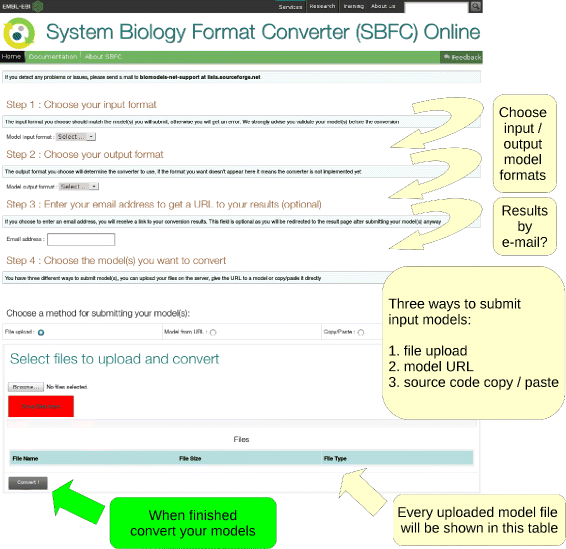Difference between revisions of "Template:Article of the week"
Shawndouglas (talk | contribs) (Updated article of the week text.) |
Shawndouglas (talk | contribs) (Updated article of the week text.) |
||
| Line 1: | Line 1: | ||
<div style="float: left; margin: 0.5em 0.9em 0.4em 0em;">[[File: | <div style="float: left; margin: 0.5em 0.9em 0.4em 0em;">[[File:Fig4 Rodriguez BMCBioinformatics2016 17.gif|240px]]</div> | ||
'''"[[Journal: | '''"[[Journal:The systems biology format converter|The systems biology format converter]]"''' | ||
Interoperability between formats is a recurring problem in systems biology research. Many tools have been developed to convert computational models from one format to another. However, they have been developed independently, resulting in redundancy of efforts and lack of synergy. | |||
Here we present the System Biology Format Converter (SBFC), which provide a generic framework to potentially convert any format into another. The framework currently includes several converters translating between the following formats: SBML, BioPAX, SBGN-ML, Matlab, Octave, XPP, GPML, Dot, MDL and APM. This software is written in Java and can be used as a standalone executable or web service. The SBFC framework is an evolving software project. Existing converters can be used and improved, and new converters can be easily added, making SBFC useful to both modellers and developers. The source code and documentation of the framework are freely available from the project web site. ('''[[Journal:The systems biology format converter|Full article...]]''')<br /> | |||
<br /> | <br /> | ||
''Recently featured'': | ''Recently featured'': | ||
: ▪ [[Journal:Chemozart: A web-based 3D molecular structure editor and visualizer platform|Chemozart: A web-based 3D molecular structure editor and visualizer platform]] | |||
: ▪ [[Journal:Perceptions of pathology informatics by non-informaticist pathologists and trainees|Perceptions of pathology informatics by non-informaticist pathologists and trainees]] | : ▪ [[Journal:Perceptions of pathology informatics by non-informaticist pathologists and trainees|Perceptions of pathology informatics by non-informaticist pathologists and trainees]] | ||
: ▪ [[Journal:A pocket guide to electronic laboratory notebooks in the academic life sciences|A pocket guide to electronic laboratory notebooks in the academic life sciences]] | : ▪ [[Journal:A pocket guide to electronic laboratory notebooks in the academic life sciences|A pocket guide to electronic laboratory notebooks in the academic life sciences]] | ||
Revision as of 16:17, 27 June 2016
"The systems biology format converter"
Interoperability between formats is a recurring problem in systems biology research. Many tools have been developed to convert computational models from one format to another. However, they have been developed independently, resulting in redundancy of efforts and lack of synergy.
Here we present the System Biology Format Converter (SBFC), which provide a generic framework to potentially convert any format into another. The framework currently includes several converters translating between the following formats: SBML, BioPAX, SBGN-ML, Matlab, Octave, XPP, GPML, Dot, MDL and APM. This software is written in Java and can be used as a standalone executable or web service. The SBFC framework is an evolving software project. Existing converters can be used and improved, and new converters can be easily added, making SBFC useful to both modellers and developers. The source code and documentation of the framework are freely available from the project web site. (Full article...)
Recently featured:










